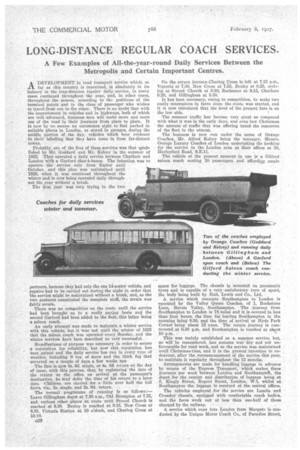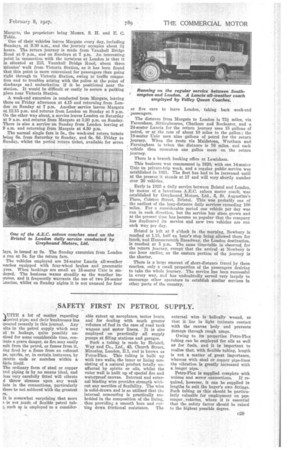LONG-DISTANCE REGULAR COACH SERVICES.
Page 94

Page 95

If you've noticed an error in this article please click here to report it so we can fix it.
A Few Examples of All-the-year-round Daily Services Between the Metropolis and Certain Important Centres.
ADEVELOPMENT in road transport service which; so far as this country is concerned, is absolutely in its infancy is the long-distance regular daily service, in many cases continued throughout the year, and, in other cases, throughout the season, according to the positions of the terminal points and to the class of passenger who wishes to travel from one to the other. There is no doubt that with the improvement in vehicles and in highways, both of which are well advanced, business men will make more and more use of the road in their journeys from place to place. It is now by no means an uncommon sight to find parked in suitable places in London, or stored in garages, during the middle portion of the day, vehicles which bear evidence In their labelling that they have come in from far-distant towns.
Probably, one of the first of these services was that egtablished by Mr. Goddard and Mr. Kelcey in the summer qf 1922. They operated a daily service between Chatham and London with a Garford char-it-bancs. The intention was to operate the service only from Easter until October, and this plan was maintained until 1926, when it was continued throughout the winter and is now being operated daily throughout the year without a break.
The first year was very trying to the two
partners, because they had only the one 14-seater vehicle, and repairs had to be carried out durin-, the night in order that the service might be maintained without a break, and, as the two partners constituted the complete staff, the strain was fairly severe.
There was no competition on the route until the service had been brought on to a really paying basis and the second Garford had been added to the fleet, this latter being a saloon coach.
An early attempt was made to maintain a winter service with this vehicle, but it -was not until the winter of 1925 that the saloon coach was operated every Sunday, and the winter services have been described as very successful. •
Steadfastness of purpose was necessary in order to secure tr reputation fpr reliability, but now this reputation has been gained and the daily service has run in every type of weather, including 6 ins, of snow and the, thick fog that occurred on a couple of days a few weeks ago The fare is now 3s. 6d. single, or 4s. 6d. return on the day of issue, with this proviso, that, by registering the date of the return ' at the office on arrival at the passenger's destination, be ma ji defer the time of his return to a later date. Children are carried for alittle over half the full fares, viz., 2s. single, and 2s. 6d. return. The normal programme of running is as follows— Leave Gillingham depot at 7.30 a.m., Old Brompton at 7.35, and various other places en route until Strood Church is reached at 9.30. Bexley is reached at.9.15, New Cross at 9.35, Victoria Station at 10 o'clock, and Charing Cross at 10.10.
c28 On the return journey-Charing Cross is left at 7.15 p.m., Victoria at 7.30, New Cross at 7.55, Bexley at 8.25, arriving at Strood Church at 9.10, Rochester at 9.15, Chatham 9.20, and Gillingham at 9.30.
It has been necessary, owing to competition, to make two costly concessions in fares since the-route was started, and it is now calculated that the level of the present fare is on the low side.
The summer traffic has become very great as compared with what it was in the early days, and even last Christmas the amount of traffic that was offering taxed the resources of the fleet to the utmost.
The business is now run under the name of Orange Coaches, Mr. Alfred Keleey being the manager, Messrs. Orange Luxury Coaches of London undertaking the booking for the service in the London area at their offices at 30,, Harleyford Road, S.E.11. The vehicle at the present moment in use is a Gi!ford saloon coach seating 20 passengers and affording ample space for luggage. The chassis is mounted on pneumatic tyres and is capable of a very satisfactory turn of speed, the body being built by Hall, Lewis and Co., Ltd.
A service which connects Southampton to London is operated by the Valley Queen Coaches, of 1, Rockstone Lane Bevois Valley, Southampton. The journey from Southampton to London is 78 miles and it is covered in less than four hours, the time for leaving Southampton in the morning being 8.30, and the time of arrival at Hyde Park Corner being about 12 noon. The return journey is commenced at 6.30 p.m. and Southampton is reached at about 10 p.m.
This was mainly established as a summer service, but, as will be remembered, last autumn was dry and not unfavourable for road work, and so the service was maintained until Christmas-time, and it is the present intention to endeavour, after the recommencement of the service this year, to maintain it regularly throughout the 12 months.
• Arrangements are made for handling luggage in advance by means of the Express Transport, which makes three journeys per week between London and Southamptofi, the depot for the receipt and distribution of luggage being at 3, Kingly Street, Regent Street, London, W.1, whilst at Southampton the luggage is received at the central offices. The vehicles employed for the service are Lancia and Crossley chassis, equipped with comfortable coach bodies, and the fares work out at less than one-half of those charged by the railway. •
A. service which runs into London from Margate is conducted by the Unique Motor Coach Co., of Paradise Street,
Margete, the proprietors being Messrs. S. II. and E. C. Tobiu.
One of their vehicles leaves Margate every day, including Sundays, at 9.30 a.m., and the journey occupies about 3} hours. The return journey is made from Vauxhall Bridge Road at 6 p.m., and on Sundays at 7 p.m. An interesting point in connection with the terminus at London is that it Is situated at 215, Vauxhall Bridge Road, about three. minutes' walk from Victoria Station, as it has been found that this point is more convenient for passengers than going right through to Victoria Station, owing to traffic congestion and to troubles arising with the police at the point of discharge ani embarkation if it be positioned near the station. It would be difficult or costly to secure a parking place rear Victoria Station.
A week-end excursion is conducted trom Margate, leaving there on Friday afternoon at 4.15 and returning from London on Sunday at 7 p.m. Another service leaves Margate at 12.15 p.m. and returns from London on Sunday at 8 p.m. On the other way about, a service leaves London on Saturday at 9 a.m. and returns from Margate at 3.30 p.m. on Sunday. There is also a service on Sunday from London leaving at 9 am, and returning from Margate at 4.30 p.m.
The normal single fare is 5s., the week-end return tickets being Os. from Saturday to Sunday, and 6s. 6d. Friday to Sunday, whilst the period return ticket, available for seven
lays, is issued at 9s. The Sunday excursion from London s run at 5s. for the return fare.
The vehicles employed are 24-seater Lancia all-weather !coaches equipped with four-wheel brakes and pneumatic .yres. When bookings are small an 18-seater Unic is emiloyed. The business waxes steadily as the weather improves, and it frequently warrants the use of two 24-seater rJancias, whilst on Sunday nights it is not unusual for four
• or five cars to leave London, taking back week-end passengers.
The distance from Margate to London is 72i miles, via Faversham, Sittingbourne, Chatham and Rochester, and a 24-seater Lancia for the return journey uses 15 gallons of petrol, or at the rate of about 10 miles to the gallon; the 18-seater Unic Uses nine gallons of petrol for the return journey. When the route via Maidstone, Wrotham and Farningham is taken the distance is 76 miles, and each vehicle then consumes one gallon more on the return journey.
There is a branch booking office at Lewisham.
This business was commenced in 1920, with one 14-seater Unic on private-trip week, and a regular public service wits established in 1921. The fleet has had to be increased until at the present it stands at 17 and will very shortly number over 20 vehicles.
Early in 1925 a daily service between Bristol and London, by means of. a luxurious A.E.C. saloon motor coach., 'was established by Greyhound Motors, Ltd, 5, St. Augustine's Place, Colston Street, Bristol. This was probably one of the earliest of the long-distance daily services exceeding 100 miles. For a considerable period one vehicle per day was run in each direction, but the service has since grown and at the present time has become so popular that the company has duplicated its service and now two vehicles are run each wax per day.
Bristol is left at 9 o'clock in the morning, Newbury is reached at 1.15, half an hour's stop being allowed there for lunch, and Hammersmith. Broadway, the London destination, is reached at 5 p.m. The same time-table is observed for the return journey, except that the arrival at Newbury is one hour earlier, as the eastern portion of the journey is the shorter.
There is a large amount of short-distance travel by these coaches, only a email proportion of the passengers desiring to take the whole journey. The service has been successful in every way, and has undoubtedly served very largely to encourage other operators to establish similar services In other parts of the country.




































































































































































































